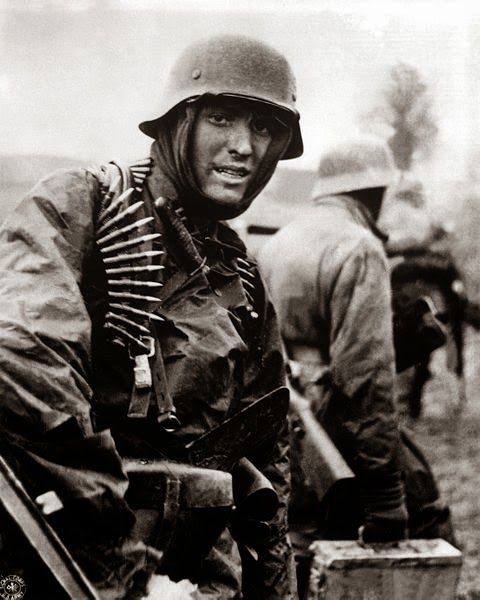Operation Carthage was an Allied air raid on the Gestapo building in Copenhagen. As the Allied armies pushed through Europe in Spring 1945, the Gestapo ruthlessly clamped down resistance movements.
Ever since the Normandy invasion, the Danish resistance had begun working in full force. On the invasion day itself, fifty Danish resistance personnel destroyed the Globus factory which manufactured parts for the V-2 rockets, and many more raids were carried out during the next six months
The SS responded by capturing and executing eight of the saboteurs on 23 june, and proclaimed an emergency in the capital.
In answer to the SS, 10,000 shipyard workers from Denmark's largest shipyards went on strike, and soon they were followed by tens of thousands of factory workers.
On the 30th of June, Hitler's personal ambassador for Denmark, Dr. Werner Best, (picturised below)
cut off electricity, gas, and water and executed a few more saboteurs. Copenhagen declared a general strike, and soon, open rebellion broke out during which a few hundreds were injured. These strikes and consequent sabotage resulted in a hold-up of several
Wehrmacht divisions which were being moved to France to block and repel the invasion.
Werner's answer to this was an SS raid on EVERY police station in Denmark. 10,000 police personnel were arrested and 2000 of them were being deported to concentration camps.
Allied High Command immediately acknowledged the contribution of the Danish resistance movement and decided to help them. Intelligence was aware that the Gestapo Headquarters in Aarhus, Copenhagen, and Odense were interrogation centers, and that dangerous information about the resistance was documented in there.
On 31 October 1944, total 25 de Havilland Mosquito aircrafts compiled from 21st Squadron RAF, 464th Squadron RAAF (Australia) and 487th Squadron RNZAF (New Zealand) hit the Aarhus buildings. In eleven minutes, they destroyed the two university buildings. Eugen Schwitzgeigel, Denmark Head of the Gestapo was killed in this raid.\
Air Vice Marshal Basil Embery suggested a raid on the Copenhagen HQ in November, and subsequently received support from Svend Truelsen, the head of the Danish resistance in London.
The building was a low U-shaped structure facing south, with the two flanks running northwards. It was originally the Denmark HQ of the Shell Oil Company, and was comandeered by the Gestapo in May `1943. The operation's purpose was to destroy the records and release the prisoners.
The same formation which had attacked Aarhus was tasked with the Copenhagen raid as well. First wave of four Mosquito aircraft's was led by Wing Cdr. Bob "Pinpoint" Bateson, and it also included Vice Marshal Embery himself. (21st Squadron RAF)
Second wave was led by Wing Cdr. Bob Iredale, with Six mosquito aircraft's. (464th Squadron RAAF)
And the third wave was lead by Wing Cdr. F. H. Denton, comprised of six mosquito aircraft's (487th Squadron, RNZAF)
Accompanying them were unarmed mosquitoes of Film and Photography department.
As soon as the mosquitoes reached the jutland coast, Bateson throttled up to 275 miles/hr. This was the signal for the entire formation to loosen out into the fan formation. Wind was calm, but visibility was low due to the windscreens clouded with dust and pulverized insects (They were flying at tree-top height)
They soon passed the Tisso Lake, and Bateson wobbled his wings again. This time, the second and third waves banked out, leaving Bateson and a few of the escorting P-51 Mustang fighters to bomb the target alone. The second wave then made a wide circuit of the lake and proceeded to target. The third wave did another circuit and proceeded to target. This separated the waves by around one minute.
Bateson was gaining on the target. The aircraft were spread 30 feet apart. The bomb-bay doors were open and the navigator was squinting at the windsheild. He suddenly pointed the pilot towards the camouflaged building of the Gestapo... the target of the raid.
Bateson came in first, and as bullets and tracers ripped past him from roof-top gunners of the target and surrounding buildings. He dropped his bombs and banked out. Vice Marshal Embery came in next. And first three bomb-loads had hit the target
But unfortunately, Wing Cdr. Peter Kleboe, who was not in forrmation got distracted by a searchlight and crashed into his tail-plane and then into the ground.
One mustang was hit while opening fire on the Anti-Aircraft defences. The raid was over in Four minutes.
Along with Kleboe and the Mustang, four other aircraft faild to return to base. One P-51 crashed on the west coast of Jutland and the pilot was taken prisoner. Two mosquitoes of 464th Squadron were shot down, and one from 487th Squadron crashed, killing the crew.
In spite of much collateral damage like the Jeanne d'Arc school, the raid was successful in destroying the records of the Gestapo concerning the Danish Resistance. A bonus was that resistance workers salvaged two filing cabinets full of names of collaborators.
After the final raid of the RAF on the Odense HQ, the Gestapo in Denmark was crippled. Denamrk was liberated only 18 days later
 Southern attacks: Erich Brandenberger
Southern attacks: Erich Brandenberger
 V-2 Rocket
V-2 Rocket